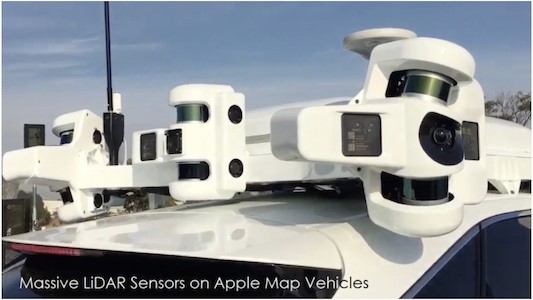
Earlier this morning Patently Apple posted a report about Apple Vans are out in full force this morning mapping out the streets of Hong Kong. These vans use massive LiDAR sensors on the roof of the vans to capture 360º images. Earlier this year Bloomberg had reported that Apple was in discussions with multiple suppliers of self-driving car sensors known as LiDAR (short for light detection and ranging), a key milestone toward development of its first passenger vehicle.
The Cupertino, California-based technology giant is in active talks with a number of potential suppliers for these laser-based sensors that allow a car’s computer to “see” its surroundings.
As it’s done with the iPhone, Apple is reportedly looking to outside vendors to supply critical hardware for a planned autonomous vehicle, according to sources. The ongoing discussions are a sign that Apple has yet to settle on a preferred supplier for LiDAR and that it’s likely mulling a range of options, including a heavily customized version of the sensors, as it moves toward developing a car design. That’s an indication that a finished product is still several years away. Review the February 2021 Bloomberg report for more.
Today, The Korea Herald reports that “Pohang University of Science and Technology has developed a nanotechnology that can reduce the size of a LiDAR sensor to smaller than that of a thumb.” This is likely a development that Apple’s research team for Project Titan will likely be investigating.
LiDAR is considered a key device to enable self-driving technologies. Typically mounted on the roofs of autonomous vehicles, conventional LiDAR sensors rotate and emit lasers to surrounding objects. By measuring the return time of light pulses, the sensors construct a 3D image of the surrounding environment.
However, mechanically rotating LiDAR sensors heat up easily and consume a lot of electricity. Also, they are bulky in size, as big as two adult fists, and cost tens of thousands of dollars.
Researchers led by professor Rho Jun-suk developed a nanotechnology that can make LiDAR sensors 1,000 times smaller in volume, when compared to the rotating type. The new invention is about 10 times smaller than the more advanced chip-shaped sensors, according to Rho.
Chip-shaped LiDAR sensors shoot an array of invisible infrared laser sources with columns and rows to achieve in-depth 3D images. These reflected beams are received as a group of points from which an image of the surroundings is then calculated.
Rho added that “If successful, the research will allow us to manufacture a high- speed and high-precision LiDAR sensor smaller than the size of a thumb at cheaper costs.”
With Apple’s Project Titan still years out, it’s possible that LiDAR sensor breakthroughs like the one at Pohang University of Science and Technology will help to advance Apple’s autonomous vehicles, making the sensors less conspicuous than they are today.
LiDAR sensors for EVs have been a cost issue, going back to Tesla’s early designs. This advance suggests a LiDAR sensor may be reduced in size significantly at cheaper cost? VisualSim can obtain the coordinates of a remote object, such that it could be interpreted, if within range, as a LiDAR object. If the VisualSim EV is also a mobile object, then it’s coordinates would be known, such that remaining objects could be processed as being visible by LiDAR. Each object in a 2D or 3D model would need a coordinate-starting point, such that all could be processed. A database block might contain object starting coordinates, current direction, if any? The big question, what happens in a North Dakota snowstorm?
Web Reference1: www.patentlyapple.com
Web Reference 2: https://www.patentlyapple.com/patently-apple/2021/05/a-promising-breakthrough-in-lidar-sensors-in-korea-could-be-a-huge-benefit-to-apples-project-titan-and-autonomous-vehicles-i.html